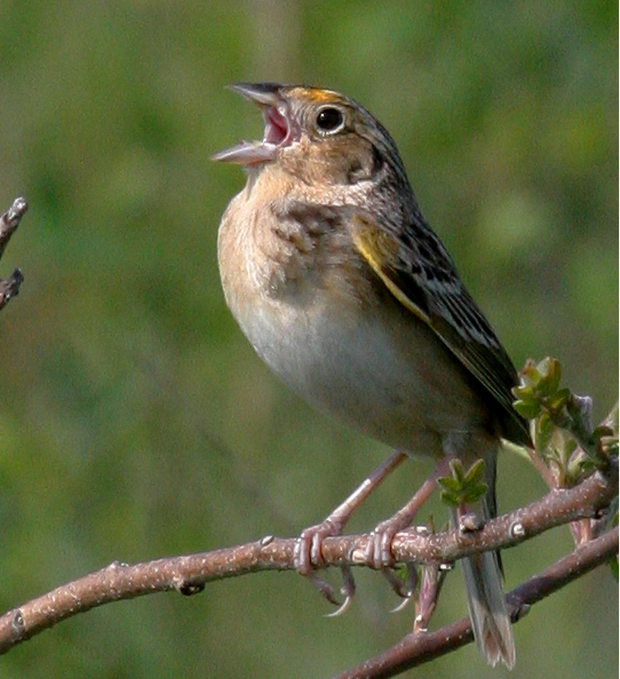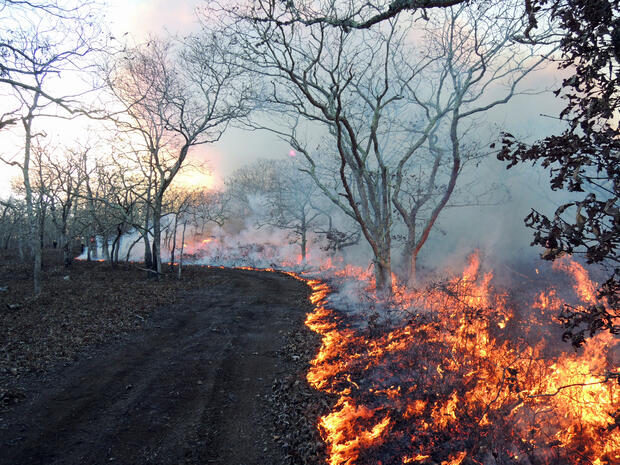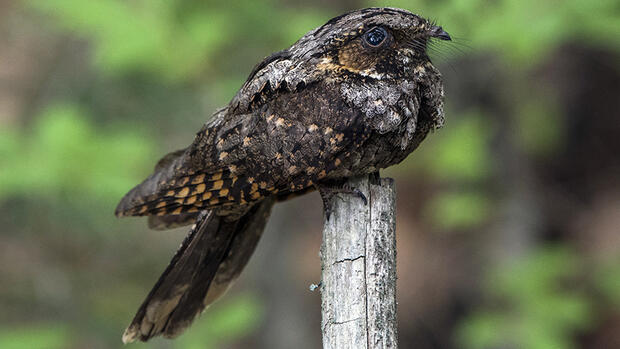Birch Hill Dam restoration (Templeton and Winchendon)
MassWildlife, in partnership with the US Army Corp of Engineers, has started work on an important project that will restore globally rare fire influenced habitats including oak woodlands and inland oak and pine barrens. The project will benefit rare and common wildlife.
The first phase of work has begun. Learn more about the project.
Frances Crane WMA habitat enhancement (Falmouth)
MassWildlife conducted extensive restoration operations to expand the globally imperiled sandplain grassland at this WMA and to improve the pitch pine and oak woodland habitat.
MassWildlife enlarged the main grassland area between 2014 and 2017 by cutting adjacent woodland, removing stumps, grading, and planting native little bluestem grass. The grassland is now nearly 400 acres in size, making it one of the largest warm season grasslands in coastal New England. During the same years, MassWildlife aggressively thinned the woodland to the east and west of the grassland and left scattered trees to promote future growth of open oak woodland with pitch pine, scrub oak, lowbush blueberries, and other native vegetation.
Work continued after 2017 with mowing, invasive plant treatments, and several prescribed burns. Mowing and prescribed burns will be conducted periodically to keep these disturbance-dependent habitats healthy.
Measuring success
Positive results of the extensive restoration projects at Frances Crane WMA can be observed on several fronts. Hunting opportunities have improved with the thinning of dense vegetation. Populations of some rare and endangered species are increasing. For example, the number of breeding pairs of grasshopper sparrows has more than quadrupled in recent years. The purple tiger beetle, which formerly occurred in low numbers in just a few small areas, is now found in greater numbers across a significantly larger portion of the WMA. Another example is sandplain gerardia, an endangered plant that has been thriving as a result of habitat management efforts.
Learn more about this project.
What does habitat restoration look like?
Each site is different, but at Frances Crane WMA a large-scale operation was needed to restore the unique sandplain grassland. The video below shows some of the work.
Video: Frances Crane WMA grassland expansion
Skip this video Frances Crane WMA grassland expansion.Herman Covey WMA barrens restoration (Belchertown, Ware)
Work at this WMA will restore a group of fire-influenced habitats, including oak-hickory woodlands and barrens. These habitats support rare and uncommon plants and wildlife, as well as a variety of game species. Approximately 75 wildlife and plant species listed under the Massachusetts Endangered Species Act (MESA) will benefit from this restoration work.
Read project summary.
Learn how this project helps wildlife and provides renewable energy.
Montague Plains WMA barrens restoration (Montague)
Montague Plains Wildlife Management Area contains the largest inland fire-influenced pine barrens habitat in Massachusetts. The deep coarse glacial sands that underlay the area gives rise to its unique features. Barrens are home to a collection of specialized plants and animals and are characterized by an open tree canopy and lots of shrubby undergrowth. This kind of habitat is both regionally and globally imperiled. Over the past two decades, several phases of tree cutting, shrub mowing, invasive plant control, and grassland planting have been completed. The open canopy and dense understory you see today is maintained by a combination of mowing and prescribed burning.
Multiple biological surveys have shown that restoration efforts are working. There is now an abundance of barrens plants including wild lupine, New Jersey tea, scrub oak, and low-bush blueberry. Uncommon and rare moths, butterflies, native bees, and reptiles—like the eastern hognose snake and eastern box turtle—are benefiting from this vibrant growth. Birds like the whip-poor-will, eastern towhee, prairie warbler, American woodcock, and ruffed grouse are making homes here and their numbers are increasing. More common species like black bear, white-tailed deer, and wild turkey are also taking advantage of the plentiful food and other habitat features created.
Take a tour! This short video will give you a sense of the work that's been done to create wildlife habitat and of the biological surveys that are ongoing at the site.
Video: Montague Plains Wildlife Management Area
Skip this video Montague Plains Wildlife Management Area.Muddy Brook WMA barrens restoration (Hardwick)
MassWildlife has completed a 500-acre barrens restoration project at Muddy Brook WMA to provide habitat for wildlife. Restoring barrens at this location is critical to conserving plants, insects, and animals—including 75 species on the Massachusetts Endangered Species List—that depend on these uncommon habitats. MassWildlife Habitat Specialists monitoring the site after restoration have seen long-absent birds like the whip-poor-will, along with pollinators and specialized plants, returning to the area. Biologists monitoring the native pollinating insects at Muddy Brook WMA observed a dramatic, positive increase as a result of restoration activities. Within one year after prescribed burns, an abundance of lowbush blueberries, native little blue stem grasses, and scrub oaks are now established in the treated areas. Read more about wildlife here.
Myles Standish Complex pine barrens restoration (Plymouth)
MassWildlife and the Department of Conservation and Recreation are restoring nearly 2,400 acres of pitch pine and scrub oak barrens in the Myles Standish Complex. These barrens habitats are naturally sandy and fire prone. The Complex is one of the few places on earth where you can explore an expansive, intact pine barrens. Our work will reduce the risk from wildfire within the Complex and restore habitat for plants and animals that thrive in this kind of environment.
If this work is not done, the specialized native plants and animals of the pine barrens will vanish from the area. As the barrens become overgrown with dense pitch pine and white pine, other plants such as low-bush blueberry or wild indigo cannot compete and eventually disappear. As their barrens habitat disappears, the many animals depending on these plants for food and cover will also disappear.
Take a tour! Watch this short video to get a view of the unique pine barrens community found at the Myles Standish Complex and learn about some of the management activities planned for the future.
Video: Myles Standish White Pine Removal Project
Skip this video Myles Standish White Pine Removal Project.Quaboag WMA habitat restoration (Brookfield)
The Quaboag River Valley has a long history of fire activity that gave rise to the unique wetland and upland habitats found there. From the late 1600s to the mid-twentieth century, agriculture was a major influence on the landscape. Today, much of the valley’s natural communities reflect that legacy of fire and abandoned agricultural practices. MassWildlife began restoration efforts in 2019. The health of the restored habitat will be maintained over time with periodic prescribed fire and occasional invasive plant treatments.
Squannacook River WMA oak woodlands restoration (Townsend & Shirley)
Biologists have begun planning a habitat restoration project in an area of the Squannacook River WMA. Restoring this regionally important oak woodland ecosystem is exciting opportunity to enhance wildlife habitat and outdoor recreation in eastern Massachusetts. The project will improve habitats that support numerous wildlife and plant species identified in the Massachusetts State Wildlife Action Plan and/or listed under the Massachusetts Endangered Species Act. Strategic tree cutting, vegetation control, and application of prescribed fire will all be used to restore this woodland ecosystem and stimulate vigorous understory growth of specialized shrubs, grasses, and flowering plants, while enhancing the oak overstory. As with all MassWildlfe’s habitat projects, this work will benefit a variety of wildlife including birds, mammals, moths, butterflies, pollinators, amphibians, and reptiles. MassWildlife is currently working through the permitting process under the Massachusetts Environmental Protection Act (MEPA) and public outreach events.
Stafford Hill WMA young forest expansion and fen restoration (Cheshire)
MassWildlife has been conducting habitat management to create and expand young forest habitat at Stafford Hill WMA for 15 years. Current work will add to the diversity of young forest age classes and will maintain open fields. The current work will also restore an uncommon type of habitat called a calcareous sloping fen.


